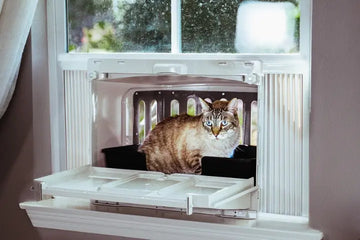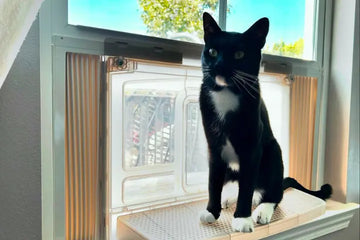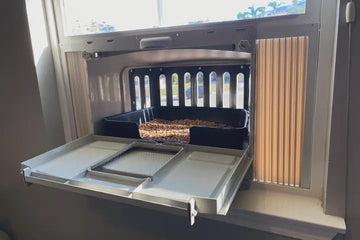Bringing a kitten into your home is a joyful and exciting experience. However, it comes with responsibilities, one of the most crucial being litter box training. Teaching your kitten how to use a cat litter box for kittens is fundamental for a harmonious living environment. This training not only helps keep your home clean and odor-free but also contributes to the health and well-being of your furry friend. Kittens are naturally inclined to bury their waste, so with patience and the right approach, litter box training can be a smooth process. By establishing good habits early on, you'll prevent potential problems and ensure your kitten grows into a well-adjusted adult cat.
Choosing the Right Litter Box for Kittens
Size and Accessibility
Your kitten should be able to easily climb in and out of the box without any help. Opt for a box with low sides initially, as small kittens might struggle with higher walls. A right-sized box not only encourages your kitten to use it but also helps prevent any intimidation or discomfort that might deter them from adopting this crucial habit. As your kitten grows, you'll want to upgrade to a larger size to accommodate their needs and ensure they remain comfortable and happy using their box.
Types of Litter Boxes
Traditional open boxes are often recommended for kittens due to their simplicity and ease of access. However, covered boxes can offer privacy and help contain odors and litter scatter as your cat matures. It's essential to introduce various types at an early stage to measure your kitten's preference. Some kittens may feel claustrophobic in covered boxes, while others appreciate the seclusion. Observing your kitten's behavior towards different box types will guide you in making the best choice for their lifelong comfort.
The Role of Litter Type
Young kittens, with their sensitive paws and curious nature, show a preference for softer litters that mimic the natural environments their instincts are drawn. Soft, non-clumping, unscented, and natural litters are generally the best choices for kittens. These types of litter are less abrasive on their delicate paws and more forgiving for their natural digging and burying behaviors. Unscented litter is particularly important because kittens have a keen sense of smell, and strong odors can be off-putting to them, potentially discouraging them from using their litter box.
Clumping litter, although popular for its ease of cleaning and ability to control odors, can be hazardous for kittens. The small particles can clump inside their digestive tract if ingested during grooming, leading to serious health issues. Therefore, it's advisable to wait until a kitten is older and less likely to ingest litter before introducing clumping varieties. Since every kitten has unique preferences and sensitivities, trying out different types of litter can help uncover what they are most comfortable with. This approach not only facilitates a smoother training process but also promotes better hygiene and well-being for the kitten.

Step-by-Step Guide to Litter Box Training
Understanding Your Kitten’s Natural Instincts
Kittens innately prefer to eliminate in soil or sand, which allows them to bury their waste. This instinct plays a crucial role in the ease of litter box training. By providing a window litter box that mimics this natural preference, you're tapping into your kitten's inherent desire to dig and cover up after themselves. Observing your kitten can give you insights into their specific preferences and behaviors, such as their chosen times for elimination and their digging habits.
Introducing Your Kitten to the Litter Box
Place your kitten in the box after meals and naps, as these are times they're most likely to need to go. Gently scratching the litter with their front paws can help trigger their instinct to dig and bury. It’s crucial to keep this experience positive and stress-free. Avoid forcing your kitten to stay in the box if they're not ready; this could create negative associations. Gentle encouragement is key during these initial introductions.
Dealing with Accidents
Accidents outside the litter box, especially with kittens, are not uncommon and are part of the learning curve in their early stages of life. The way you handle these incidents is crucial in guiding your kitten towards the correct use of the litter box and ensuring they grow up feeling secure and understood. Here's a straightforward approach to handle accidents and reinforce good behavior:
- Clean Up Accidents Immediately: Promptly cleaning up any accidents is essential in preventing your kitten from returning to the same spot due to lingering odors. Removing these smells quickly helps to discourage repeat offenses and keeps your home clean and odor-free. It’s also the first step in how to teach kitten to use litter box.
- Calmly Place Them in the Litter Box: If you catch your kitten amid an accident, it's important to react calmly. Gently placing them in the box can help them associate the act of elimination with the correct location. If they continue in the litter box, offering praise reinforces this positive behavior, making them more likely to repeat it.
- Reward Correct Litter Box Use: Whenever your kitten uses the litter box correctly, reward them with treats, affection, or playtime. This positive reinforcement makes them more likely to use the box consistently, as they begin to associate it with positive outcomes. It's a kind and effective way to encourage the behavior you want to see.
- Never Punish Your Kitten: Punishment for accidents can lead to fear, anxiety, and even aversion to the litter box, which can be counterproductive to your training efforts. Instead of punishment, try to understand why the accidents are happening and adjust your approach.
Dealing with accidents through understanding and positive reinforcement not only aids in your kitten's cat bathroom training but also strengthens the bond between you and your pet. It creates a foundation of trust and communication that will benefit both of you throughout your kitten's life.
Optimal Placement of the Litter Box
Quiet and Accessible Location
Cats, being both predators and prey in the wild, are instinctively drawn to areas where they can conduct their business in peace, without feeling exposed. This behavior translates into the domestic setting, where the hustle and bustle of household traffic can be unsettling for them. Young kittens, in particular, need to be able to reach their catio litter box without too much effort or obstacle, as their developing bodies and minds are still mastering the coordination and control necessary for such tasks. If a litter box is too hard to reach or find, a kitten may resort to eliminating it in inappropriate places, leading to a challenging habit to break. It's also crucial to avoid placing the litter box near the kitten's food and water bowls. Cats have a natural aversion to eating near their elimination areas, a trait likely evolved to avoid contaminating their food sources.
A secluded corner in a room where the kitten spends much of their time strikes a balance between privacy and accessibility. It provides a sanctuary for them to relieve themselves while ensuring they remain engaged with the family or caretaker's activities, avoiding feelings of isolation. The chosen room should remain accessible to the kitten at all times, ensuring that their access to the litter box is not hindered by closed doors or sudden changes in the environment.
The Number of Litter Boxes
A common rule of thumb is to have one box for each cat in the home, plus one extra. This guideline ensures that your kitten always has access to a clean box, reducing the chances of accidents. Multiple boxes are especially important in multi-level homes; having a litter box on each floor prevents your kitten from having to travel too far. This setup is particularly beneficial during the early stages of litter box training when your kitten is still learning where to go and may not make it in time to a distant box.
When to Move or Add More
Any changes in your living situation, such as moving to a new house or introducing new family members (pets or humans), could necessitate adjusting the number or location of litter boxes to accommodate your cat's evolving needs. Regularly evaluate your home environment and your cat's behavior to determine if changes to the litter box setup are needed for optimal training and use.

Maintaining a Clean Litter Box
Cleaning Frequency
Daily scooping is recommended to remove waste, with a thorough cleaning of a litter box occurring weekly. This routine helps prevent odors and maintains a fresh environment, encouraging your kitten to keep using the box. Balancing cleanliness with your kitten's sense of familiarity is key; abrupt changes in scent or litter type can be off-putting. Thus, when introducing new litter or cleaning products, do so gradually to allow your kitten to adjust.
The Right Cleaning Products
Enzyme-based cleaners are effective at breaking down odors and stains without leaving harmful residues. It's essential to avoid products with strong fragrances or harsh chemicals, as these can deter your kitten from using the box. Natural and unscented cleaners are often the best choice, ensuring the litter box remains inviting without overwhelming your kitten's sensitive sense of smell.
Transitioning to Different Litter Types or Boxes
As your kitten grows, you may find the need to transition to different types of litter or even different litter boxes. This change could be driven by your kitten's developing preferences, health recommendations, or simply the desire for a more convenient cleaning solution. A gradual transition is key to ensuring your kitten adjusts without resistance. Start by mixing a small amount of the new litter with the old, gradually increasing the new litter's proportion over several days. Similarly, if introducing a new box, place it alongside the old one initially to allow your kitten to explore and become accustomed to it at their own pace.
Enhancing the Litter Box Experience
Cat Window Box or Catios
Incorporating catios or a window litter box for cats can significantly enhance your kitten's litter box experience. A catio, an outdoor cat enclosure, offers fresh air and stimulating views, creating a pleasant environment for your kitten to explore and relax. Similarly, a window litter box for cats provides an engaging perspective, allowing your kitten to stay entertained while taking care of their needs. These options not only enrich your kitten’s environment but also encourage litter box use by associating it with positive, stimulating experiences.
Natural Light and Ventilation
Sunlight, a natural disinfectant, plays a crucial role in minimizing odors associated with the litter box. It not only helps in breaking down bacteria that contribute to unpleasant smells but also provides a warm and inviting area for your kitten. This warmth is not just physical; it creates a psychologically comforting space, making the kitten more inclined to use the litter box regularly.
Ventilation, on the other hand, ensures the circulation of fresh air, crucial for diluting and removing the ammonia smells that can quickly accumulate in a poorly ventilated area. Effective ventilation maintains a fresh environment around the litter box, discouraging the buildup of overpowering odors that could deter your kitten from using it. Fresh airflow not only benefits your kitten by providing a more appealing environment but also contributes to the health and comfort of the entire household.
Alternatives to Traditional Litter Boxes
Exploring alternatives to traditional litter boxes can significantly enhance the litter box experience for both cats and their owners. Let's delve into these alternatives and how they might suit your household:
- Self-Cleaning: For those seeking convenience and cleanliness, self-cleaning litter boxes are a revolutionary option. These automated boxes are designed to sift and remove waste shortly after your cat uses it, drastically reducing the need for manual scooping. This not only keeps the litter box fresh and odor-free but also is ideal for busy pet owners or those who dislike the daily maintenance of traditional litter boxes.
- Top-Entry: These are perfect for cats that tend to kick litter out of the box or for owners looking to minimize litter tracking around the house. The top-entry design forces cats to jump in and out, catching any litter stuck to their paws on the lid. Additionally, these boxes offer more privacy for your cat, which some pets prefer, and can deter dogs from getting into the litter.
- Hidden: Hidden litter boxes are cleverly designed to blend with your home decor, resembling furniture like plant pots, cabinets, or benches. This alternative is ideal for those who prefer not to have a visible litter box in their living space. Not only do they serve a functional purpose, but they also add aesthetic value to your home, making the presence of a litter box less conspicuous.
- Disposable: These are a convenient solution for travel, temporary setups, or for those who prefer not to clean and maintain a traditional litter box. Disposable boxes come pre-filled with litter and can be simply thrown away after a certain period of use. They offer a hassle-free option, ensuring that your cat always has a clean place to go, without the need for washing and refilling.
Choosing an alternative to the traditional litter box can address specific challenges and preferences, ensuring that both you and your cat are happy and comfortable. Whether you prioritize ease of cleaning, aesthetics, or litter box placement strategies, there's an option out there that can meet your needs and enhance your living space.
Training your kitten to use the litter box is an essential part of pet ownership that, when approached with care and thoughtfulness, can be a straightforward and rewarding experience. By following the steps outlined in this guide, you're well on your way to providing a healthy, hygienic environment for your kitten and a peaceful, odor-free home for yourself. Patience and persistence are key—know that with time, your kitten will learn and adapt to this important aspect of their daily routine.

